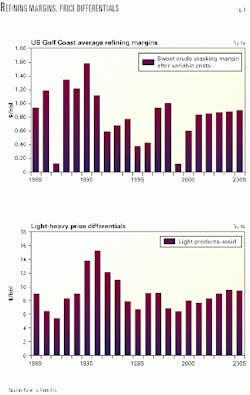Global refining margins will continue to recover in the near term but may weaken later this year, says Purvin & Gertz Inc., Houston.
Despite positive market fundamentals such as a post-Asian-crisis recovery in demand, the analyst noted that global refining margins remained in the doldrums during 1999.
In 1999, US refined products demand increased by 2.3%, but this demand growth was offset by an increase in capacity by 3.1%.
The partial restart of the Orion (formerly the Good Hope refinery and Trans American Refining Corp.) refinery in Louisiana last year played a key role in the capacity increase (OGJ, Dec. 21, 1998, p. 41). The refinery announced in mid-July that its entire complex is in operation.
Purvin & Gertz notes that the restart up of these facilities will be a threat to margins.
Market outlook
A look at historical margins (Fig. 1a) indicates that 1987, 1995, and 1999 were very bad years for US refiners. (The low point in 1995 covers the end of 1995 and early 1996; so the annual values moderate the results).
Each of these periods shared many common features, such as rapidly rising crude oil prices, perceptions that high prices would not last, increasingly backwardated markets, and rapidly growing refinery capacity.
"During periods of high prices, crude oil producers contribute to market backwardation by seeking to lock in favorable prices and thereby put selling pressure on the outer months," said Purvin & Gertz.
"Because of the backwardation, refiners are unable to cost-effectively hedge purchase and inventory risks, so they go to 'just in time' stocking practices, further contributing to the backwardation. The liquidation of inventory creates product surpluses and drives down product prices while near-term crude oil prices remain strong. The result is terrible margins."
When the inventory liquidation process nears completion, product supplies become short, and refining margins improve. "Refining margins over the last several months have been very strong, reflecting the low product stock buffersellipse.We look for margins to fall following the summer, and expect lower levels in 2001."
Light-heavy differentials
Price differentials between light refined products and residual fuel oil and between heavy and light crude oils are key elements that contribute to US refining profitability. These differentials also fell to extremely low levels in 1999 but have increased considerably in recent months (Fig. 1b).
"The production cutbacks of 1999 significantly tightened the world balance of residual components by preferentially reducing the production of heavy crudes," said Purvin & Gertz.
"Strong drought-related demand in Mexico strengthened regional demand for residual fuel oil. This demand has now subsided. The low level of residual fuel oil demand (US demand is now only about 800,000 b/d) enables small changes in the balance to cause large changes in prices.
"As crude production grows to meet demand, heavy crude production will increase and result in wider light-heavy differentials through the early years of this decade. However, if conversion capacity additions remain at the current high rates, or if another wave of overbuilding accompanies future sulfur-reduction programs, light-heavy differentials could remain depressed."
Europe
Refining margins in Europe last year fell to their lowest levels since 1985, and catalytic cracking margins dropped to about $1/bbl vs. relatively strong levels in 1998, Purvin & Gertz noted.
Margins for hydroskimming, which represents the incremental supply in Europe, fell below $1/bbl on a variable-cost basis. As a result, capacity utilization in Europe dropped to 89% from 93% in 1998.
In 1998, Europe's light and heavy differentials recovered. The gasoline and fuel oil spread increased to $88/tonne from $73/tonne, and the gas oil and fuel oil spread rose to $52/tonne from $44/tonne, despite high middle distillate stocks. Demand for heavy fuel oil fell by 3.5% in 1999 from the 1998 level, because of reduced power-generation demand and increased penetration of natural gas, especially in the Italian power industry.
"The lower demand has put pressure on heavy fuel oil prices, leading to lower hydroskimming margins due to the high fuel oil yield from this type of refining capacity," said Purvin & Gertz. "With crude oil prices expected to ease this year and product stock levels declining, we expect catalytic cracking margins to recover over the next few years.
"However, continuing declines in heavy fuel oil demand are likely to keep hydroskimming margins under pressure and improve the economics of residue conversion from current levels."
Asia
Due to Asia's economic slump and excess refining capacity last year, Singapore refining margins dropped to variable-cost break-even or less. Singapore's refining operating rates were a little over 70%, as depressed regional refined product demand was met by new capacity.
Continuing construction of new refining capacity in the region will continue to keep pressure on margins. Formosa Plastics Group's 450,000 b/d new refinery in Taiwan will come on stream this year. Reliance Petroleum Ltd.'s expansion of its refinery in India will bring plant capacity to 540,000 b/d this year.
The anticipation of weak refining margins prompted Royal Dutch/Shell's 440,000 b/d refinery in Singapore to cut operating rates to 50%: "However, refiners can expect some relief, as a large volume of Asian refining capacity is scheduled to go down for maintenance turnaround later this year," said Purvin & Gertz.
"In the years ahead, Asian markets will present significant challenges to the refining industry. Anticipated fuel quality changes will require tough decisions on major refining investments," the analyst said.
"However, continued industrialization, urbanization, and population growth will ensure healthy petroleum demand growth. Asia will eventually grow itself out of the current margin malaise, unless capacity additions again outpace demand growth."



